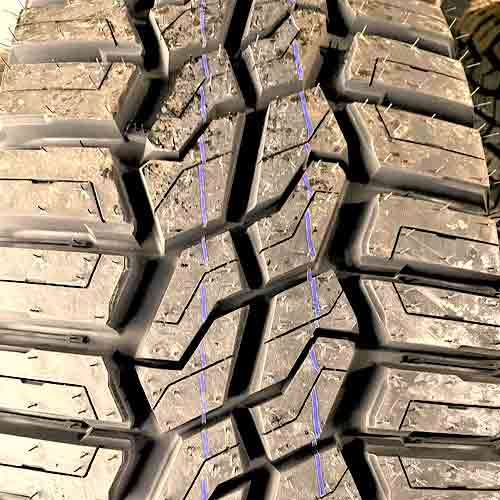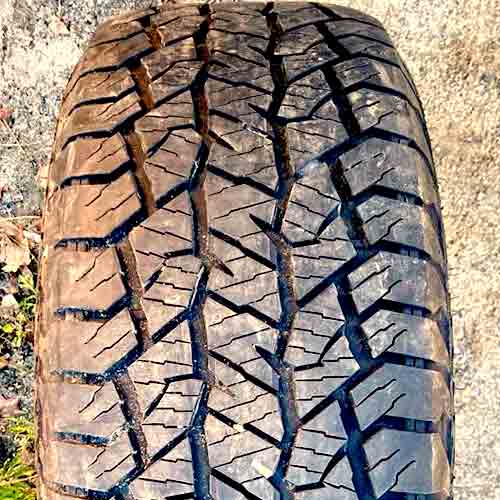With their advanced tread compounds, both the Hankook Dynapro XT and the Dynapro AT2 are set to impress and deliver exceptional efficacy on and off-road. Though since they perform very differently, its wise to consider their performance in all considerable areas. Let’s find them all out.

Being a tire engineer, from my perspective, the Hankook Dynapro XT although provides decent dry grip on pavements, it really need some traction on wet roads. Though its winter traction is almost on par to its competitor. And off-road it’s a beast. In comparison, the Dynapro AT2 shines on highways, and offers superior traction on dry and wet roads. And, its also better when it comes to fuel, comfort and on-road noise.
Tire Specs
Starting with Hankook Dynapro AT2, this tire has following specs.
- Sizes: 15 to 22 inches
- Speed rating: S and T.
- Load Rating: SL, XL, C, D, E, and F.
- Weight: 29 to 80 lbs
- Tread depth: 12 to 16.4/32″
- Warranty: 60k miles for all.
- Internal construction: 3 ply polyester + 2 steel belts + 2 nylon plies.
On the other side, the Hankook Dynapro XT, comes with following
- Sizes: 31 total sizes in 17 to 20″.
- Speed rating: R only.
- Load Rating: C to E.
- Weight: 45 to 77 lbs.
- Tread depth: 15.5 to 17/32″
- All have 3PMSF and M+S winter ratings.
- Warranty: 50k miles for all
- Internal construction: same as Dynapro AT2.
Tread Features
Starting with Hankook Dynapro XT, the tread on this tire features a more open design, though with limited overall biters, comparatively.

Let me start off form the middle.
So there are two ribs here, very compressed up together by the outer circumferential channels, (that’s why, inner longitudinal grooves are narrower).
Both central ribs have identical lugs, having sharp edges, interlocking sipes and in-groove notches.
These yield off-road traction, whereas the foundational supports underneath these lugs, offer stability on highways.
Same goes for shoulders, their blocky design, and reinforced foundations provide lateral grip on pavements, and with their elongated structure, account for a great mud and dirt removal off-road (as they come with wider grovoes and self-cleaning stone ejectors).
Though the tire’s outer edges are not staggered, and the sidewall lugs could use some rubber just like its little brother.
Speaking of which, the Hankook Dynapro AT2 on the other hand, offers similar longitudinal structure with more biters though.

This dude gives you 5 total ribs, forming 4 longitudinal channels of zigzag shapes.
The inner most ribs has lugs which are very well engineered for both on and off-road.
With biters facing in all directions and full depth sipes, which split open the blocks, the tire offers traction on multiple terrains (off-road).
And as this rib is made continuous (lugs sit on a secondary consistent running layer underneath), they provide on road stability with that as well.
These (central most) lugs are also wider compared to outer ones, so this further adds to that.
The surrounding ribs have lugs running in pairs, and so they are slightly more open, though they are missing with notches, but carry other similar features.
Lastly shoulder lugs carry similar features, and on the outskirts, they are not staggered, and are missing with sidewall lugs.
Wet Traction
Wet traction can be optimized by focusing on two key elements: grip and resistance to hydroplaning. So lets take a closer look on both.
And even though both tires are great in the hydroplaning department, with their ample tread voids, clearing water off at a major scale, the Hankook Dynapro XT can’t deal effectively with the left over (which have to wiped off with sipes).
These sipes basically are just slits on the tread, and they squeeze to slurp water in themselves, clearing off the pathway for the tire, so it can grip easily.
The Hankook Dynapro AT2 features ample of those interlocking ones all over the tread, so it no wonder you see better handling times here.
Highway Performance
To get a clear understanding of an all-terrain tire’s dry performance, it’s necessary to consider its traction, steering, and cornering abilities. Let’s delve into each of these important factors in more detail.
Directional
Directional grip is the rolling traction of a tire on a straight path. That’s why its calculated with braking distances and acceleration times. And it highly depends on the central section of the tread, as that area gets the most weight concentration on itself.
That’s why out of both boys, the Hankook Dynapro AT2 comes out with better response, thanks to it’s central most (continuous) running rib, of larger proportion.
Hankook Dynapro XT on the other side has wider longitudinal grooves there instead, limiting the area of tread to be in contact with the surface, so naturally grip here is compromised.
That’s why it’s sizes gets to offer lower speed ratings (only up to R).
Dry Handling
The ground-outer lugs making contact with the ground is a crucial factor in determining the lateral traction, as during turns the weight gets shifted there.
That’s why, with wider tread voids there, the Hankook Dynapro X/T lacks to its counterpart.
Dynapro AT2 on the other side, although is missing out with bold stone ejectors, it’s compacted up shoulders still account for superior handling capabilities.
Moreover with its harder compound, and solid foundational supports, it also gets to render faster steering response (as lugs aren’t that prone to bending/flexing, when the tire corners).
Fuel Consumption
Fuel consumption is closely tied to the rolling resistance of the tires, with the weight and tread composition/structure playing a vital role.
And here although it may seem counterintuitive, the Hankook Dynapro AT2 takes the lead even with its (slightly) greater weight. So why is that? Let me explain.
Basically the tire comes with smaller tread voids, and so all it’s lugs divide up that weight more evenly in a way that each lug gets to bear smaller pressure on itself.
The Hankook Dynapro XT on the other side not only comes with greater voids, but its lugs are also more prone to flexing (as already discussed in the steering response section), so energy is being wasted in to bending of the lugs, rather than rolling of the tire.
Tread Longevity
As the Dynapro XT comes out with larger rolling resistance values, it gets to burn it’s rubber relatively faster.
This is because with wider gaps between the tread blocks, all lugs bear more pressure on themselves, rubbing off the road with greater force. (Moreover, its softer tread compound isn’t resisting to that).
Hankook Dynapro AT2 on the other side, delivers a more evenly distributed weight, and a harder compound, combined with decent tread depth. All these features allow it to have longer life, before it comes down to 2/32″ of the tread depth legal limit.
Snow Traction
Both tires show amazing capabilities on all types of snowy terrains, that’s why both of them are branded with 3 peak mountain snowflake ratings.
Though still out of them , the Hankook Dynapro AT2 features superior traction efficacy, on hard packed up snow, which is credited to it’s numerous biters, in the form of in groove notches, and off-set edges.
Whereas the Dynapro X/T yields better results on softer/deeper terrains, where it’s bigger shoulder blocks provide the scooping.
Off Road Traction
To handle rugged paths effectively, tires must have specific skills for each terrain type. That’s why I studied both boys in following terrain types.
Rocky Trails
A tire suitable for driving on rocky tracks should have a pliant, soft tread with lugs that can grip from multiple directions. Moreover, it also needs to have powerful internal construction, as this terrain is where most of punctures happen.
When it comes to both of these brothers, although durability is not going to be an issue with both of them, as they offer 3 ply polyester casing (protecting the sidewalls), the overall gripping values are still seen better on Dynapro X/T (according to my testing, and experience).
XT basically offers bigger groove mouth, and features a relatively more flexible tread compound capable of biting with greater force.
In addition, with lowered air pressure, the tire also spreads out it’s sidewall lugs, enhancing rock grabbing abilities, further.
Muddy Tracks
The use of all-terrain tires in mud presents a challenge, but this can be overcome with a tread design featuring wider grooves, which can effectively evacuate out the thick clay preventing mud packing, improving traction.
That’s why the Hankook Dynapro XT shows up better on this terrain type as well.
It’s greater voids to tread ratio combined with bolder stone ejectors supplies superior self cleaning of the tread. And it’s elongated shoulder lugs and biters on sidewalls account for paddling effect, even when the tire is stuck knee deep in mud.
Dynapro AT2 on the other side is not that, what you say “bald” and is missing with sidewall lugs, so it figures why it’s lacking here.
On Sand
Sand driving requires a tires with specific properties, including soft tread pattern, and lightweight construction, both of these account for better floating abilities, which is exactly what you want on this terrain type.
(That’s why balloon and paddle tires do so great here). Read More in, are A/T good on sand?
And so out of both boys, the Dynapro XT won’t let you down (literally). The tire has less sharper outer edges, and comes with sidewall lugs, which spread out and prevent digging with enhanced contact patch.
Hankook Dynapro AT2 on the other side, is not only missing with these sidewall lugs (as already mentioned), but you also get to have a heavier structure combined with stiffer outer edges, so keeping forward momentum going for this tire is a bit more tricky, especially when it comes to slopes.
Ride Quality
When it comes to overall comfort of the ride, there are 3 things involved, tread noise, bumps absorption, and on-road stability.
Out of them although we have already covered the stability part, with Dynapro AT2 showing better results (with its superior steering response), the tire also shows better results in the noise dampening department as well.
It features superior variable pitching, thanks to its greater lug-geometry variations. This allows for air particles hitting the walls of the tread to create different noise tones (at different parts of the tread), and they all try to cancel out each other’s frequencies.
Moreover as most of that air comes in through shoulder voids, its closed up structure there kills the noise at the source.
Hankook Dynapro XT on the other hand, features a balder structure, so air flow is less restricted on this tire, rendering a louder ride.
Though the tire’s softer tread compound does offer superior settling of the vibrations on and off-road (especially on gravel).
Leave With This
The Hankook AT2 is a better tire when it comes to on-road traction (in both dry and wet environments). And you also get superior fuel, treadwear and noise dampening performance as well.
The Dynapro X/T on the other hand, is although not so bad on roads, it really lacks on wet. Though it evens out that with its superior off-road performance in almost all areas.
Excellent comparison review!